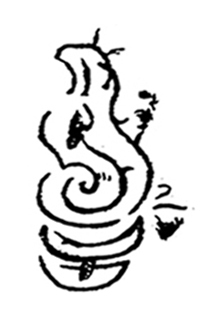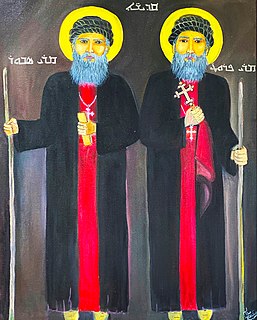
The Kingdom of Travancore (/ˈtrævənkɔːr/), also known as the Kingdom of Thiruvithamkoor, was an Indian kingdom from c. 1729 until 1949. It was ruled by the Travancore Royal Family from Padmanabhapuram, and later Thiruvananthapuram. At its zenith, the kingdom covered most of the south of modern-day Kerala, and the southernmost part of modern-day Tamil Nadu with the Thachudaya Kaimal's enclave of Irinjalakuda Koodalmanikyam temple in the neighbouring Kingdom of Cochin. However Tangasseri area of Kollam city and Anchuthengu near Attingal in Thiruvananthapuram district, were British colonies and were part of the Malabar District until 30 June 1927, and Tirunelveli district from 1 July 1927 onwards. Travancore merged with the erstwhile princely state of Cochin to form Travancore-Cochin in 1950. The five Tamil-majority Taluks of Vilavancode, Kalkulam, Thovalai, Agastheeswaram, and Sengottai were transferred from Travancore-Cochin to Madras State in 1956. The Malayalam-speaking regions of Travancore-Cochin merged with the Malabar District and the Kasaragod taluk of the South Canara district in Madras State to form the modern Malayalam-state of Kerala on 1 November 1956, according to the States Reorganisation Act, 1956 passed by the Government of India.

Sree Padmanabhadasa Sree Chithira Thirunal Balarama Varma, popularly known as Sree Chithira Thirunal, was the last ruling Maharaja of the Princely State of Travancore, in southern India until 1949 and later the Titular Maharajah of Travancore until 1991. Sree Chithira Thirunal was the eldest son of Junior Maharani of Travancore, H.H. Sree Padmanabhasevini Vanchidharmavardhini Rajarajeshwari Maharani Moolam Thirunal Sethu Parvathi Bayi, and Sri Pooram Nal Ravi Varma Koyi Thampuran of the Royal House of Kilimanoor. He was privately educated, and became the Maharajah of Travancore, at the age of 12, upon the death of his maternal great uncle, the then Maharajah of Travancore Sree Moolam Thirunal, on 7 August 1924.

Kingdom of Cochin, named after its capital city of Kochi, was a kingdom on the Malabar Coast in Kerala, that ruled from the early 12th century to 1949.

Travancore–Cochin, or Thiru–Kochi, was a short-lived state of India (1949–1956). It was originally called United State of Travancore and Cochin following the merger of two former kingdoms, Travancore and Cochin on 1 July 1949. Its original capital was Thiruvananthapuram. It was renamed State of Travancore–Cochin in January 1950. Travancore merged with erstwhile princely state of Cochin to form Travancore–Cochin in 1950. The five Tamil-majority Taluks of Vilavancode, Kalkulam, Thovalai, Agastheeswaram, and Sengottai were transferred from Travancore-Cochin to Madras State in 1956. The Malayalam-speaking regions of the Travancore–Cochin merged with the Malabar District and the Kasaragod Taluk of South Canara district in Madras State to form the modern Malayalam-state of Kerala on 1 November 1956, according to the States Reorganisation Act, 1956 passed by the Government of India.

Ottapalam, is a town in Ottapalam taluk of the Palakkad district in Kerala, India.

Venad was a medieval kingdom lying between the Western Ghat mountains and the Arabian Sea on the south-western tip of India with its headquarters at the port city of Kollam/Quilon. It was one of the major principalities of Kerala, along with kingdoms of Kannur (Kolathunadu), Kozhikode (Nediyiruppu), and Kochi (Perumpadappu) in medieval and early modern period.

Malabar District, also known as Malayalam District, was an administrative district on the southwestern Malabar Coast of Bombay Presidency (1792-1800) and Madras Presidency (1800-1947) in British India, and independent India's Madras State (1947-1956). It was the most populous and the third-largest district in the erstwhile Madras State. The British district included the present-day districts of Kannur, Kozhikode, Wayanad, Malappuram, Palakkad, Chavakad Taluk and parts of Kodungallur Taluk of Thrissur district, and Fort Kochi area of Ernakulam district in the northern and central parts of present Kerala state, the Lakshadweep Islands, and a major portion of the Nilgiris district in Tamil Nadu. The detached settlements of Tangasseri and Anchuthengu, which were British colonies within the kingdom of Travancore in southern Kerala, also formed part of Malabar District until 1927. Malayalam was administrative as well as most spoken Lingua franca of Malabar District during British Rule. Jeseri, a distinct dialect of Malayalam, was spoken in the Laccadive Islands. Malabar District merged with the erstwhile state of Travancore-Cochin (1950-1956) to form Kerala according to the States Reorganisation Act, 1956. On the same day, the present Kasaragod district of South Canara District was also attached to Malabar, and the Laccadive&Minicoy Islands of Malabar were reorganised to form a new Union Territory. Malabar was trifurcated to form the districts of Kannur, Kozhikode, and Palakkad, on 1 January 1957.
The term Kerala was first epigraphically recorded as Keralaputra (Cheras) in a 3rd-century BCE rock inscription by emperor Ashoka of Magadha. It was mentioned as one of four independent kingdoms in southern India during Ashoka's time, the others being the Cholas, Pandyas and Satyaputras. The Cheras transformed Kerala into an international trade centre by establishing trade relations across the Arabian Sea with all major Mediterranean and Red Sea ports as well those of Eastern Africa and the Far East. The dominion of Cheras was located in one of the key routes of the ancient Indian Ocean trade. The early Cheras collapsed after repeated attacks from the neighboring Cholas and Rashtrakutas.
The Kochi Municipal Corporation is the municipal corporation that manages a portion of the Indian city of Kochi in the state of Kerala. The Corporation manages 94.88 km2 of Kochi city and has a population of 677,381 within that area. It is the most densely populated city corporation in the state.

Kochi is a metro city located in the Ernakulam District in the Indian state of Kerala. Kochi, which is the largest city in Kerala is located about 200 km from Trivandrum, the capital of Kerala.

Kerala Day also referred to as Kerala Piravi, marks the birth of the state of Kerala in southern India. The state of Kerala was created on 1 November 1956, long after the Independence of India. Before this, it was three major provinces and several outlying regions under various rulers.

North Malabar refers to the geographic area of southwest India covering the state of Kerala's present day Kasaragod, Kannur, and Wayanad districts, and the taluks of Vatakara, Koyilandy, and Thamarassery in the Kozhikode District of Kerala and the entire Mahé Sub-Division of the Union Territory of Puducherry. Traditionally North Malabar is defined as the northern portion of erstwhile Malabar District which lies between Chandragiri River and Korapuzha River. The region between Netravathi River and Chandragiri River, which included the portions between Mangalore and Kasaragod, are also often included in the term North Malabar, as the Kumbla dynasty in the southernmost region of Tulu Nadu, had a mixed lineage of Malayali Nairs and Tuluva Brahmins.

Kerala Varma Thampuran popularly known as Aikya Keralam Thampuran or Kerala Varma VII was the Maharaja (king) of Cochin who ruled between 1946 and 1949. He mooted the idea of a unified Kerala state in India for the Malayalam speaking population and stood for the merging of British Malabar, Cochin and Travancore. Therefore, he was given the sobriquet Ikyakeralam Thampuran. He died in July 1948. He was also the brain behind the formation of Sree Kerala Varma College at Thrissur, named after him.

The Malabar Coast is the southwestern coast of the Indian subcontinent. Geographically, it comprises the wettest regions of southern India, as the Western Ghats intercept the moisture-laden monsoon rains, especially on their westward-facing mountain slopes. The term is used to refer to the entire Indian coast from the western coast of Konkan to the tip of the subcontinent at Kanyakumari. The peak of Anamudi, which is also the point of highest altitude in India outside the Himalayas, and Kuttanad, which is the point of least elevation in India, lie on the Malabar Coast. Kuttanad, also known as The Rice Bowl of Kerala, has the lowest altitude in India, and is also one of the few places in the world where cultivation takes place below sea level.

Quilon or Coulãopronunciation (help·info), officially Kollampronunciation (help·info) is one of the ancient civilizations in India.It is one of the oldest port cities in the Malabar Coast and was the capital city of historic Venad Kingdom and Travancore Kingdom. Quilon was once an important trading port in India. It was also known as Desinganadu. It is now known as the "Cashew Capital of the World".

Kannur, formerly known in English as Cannanore, Arabic as Kannanur, and Portuguese as Cananor, is a city and a Municipal Corporation in North Malabar region, state of Kerala, India. It is the largest city in North Malabar, which is the northernmost region of Kerala. It is sometimes identified Kolathunadu, which was ruled by the Kolathiris. In the 12th and 13th centuries there was trade with Persia and Arabia.

The Reformation movement in Kerala refers to a socio-cultural movement that began towards the end of 19th century and led to large scale changes in the social outlook of the southern Indian state of Kerala.

South Malabar refers to a geographical area of the southwestern coast of India covering some parts of the present-day Kerala. South Malabar covers the regions included in present-day Kozhikode Taluk of Kozhikode district, whole area of Malappuram district, Chavakkad Taluk of Thrissur district, and Palakkad district excluding parts of Chittur Taluk. The Fort Kochi region of Kochi city also historically belongs to South Malabar. The term South Malabar refers to the region of the erstwhile Malabar District which lies south to the river Korapuzha and bears high cultural similarity with both the Cochin as well as the North Malabar region.

K. A. Damodara Menon (1906-1980) was an Indian National Congress politician, minister, journalist, writer, freedom fighter and an activist in the movement for united Kerala. He was elected to the Provincial Parliament in 1950 and Indian Parliament from Kozhikode as a representative of Kisan Mazdoor Praja Party, in 1952. During his term as a member of Kerala Legislative Assembly, he served as the Minister for Industries and Local Administration.



















